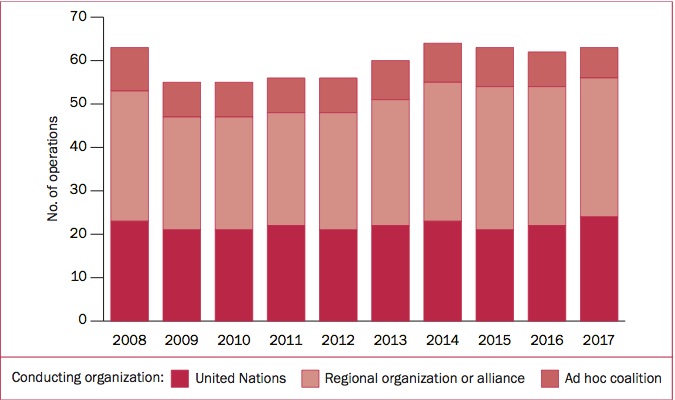3. Peace operations and conflict management
Overview, Jaïr van der Lijn [PDF]
I. Global trends and developments in peace operations, Timo Smit and Jaïr van der Lijn [PDF]
II. Regional trends and developments in peace operations, Jaïr van der Lijn and Timo Smit [PDF]
III. Multilateral non-peace operations, Jaïr van der Lijn [PDF]
IV. Table of multilateral peace operations, 2017, Timo Smit [PDF]
In contrast to 2016, 2017 was a hectic year for peace operations, both in the field and at headquarters, particularly for the United Nations. The fall in the total number of personnel deployed in peace operations, which began in 2012 with the drawdown of the International Security Assistance Force (ISAF), continued in 2017. The total number of personnel deployed in the field declined by 4.5 per cent during 2017 to 145 911. Although UN deployments had been on the rise before 2016, they fell in 2017, by 7.6 per cent, whereas the number of personnel in non-UN operations increased by 2.3 per cent to 47 557.
Trends and developments in peace operations in 2017
There were 63 multilateral peace operations active during 2017, one more than in 2016. Three UN peace operations closed: the UN Operation in Côte d’Ivoire (UNOCI), the UN Mission in Colombia (UNMC) and the UN Stabilization Mission in Haiti (MINUSTAH). The latter two were replaced by smaller missions: the UN Verification Mission in Colombia (UNVMC) and the UN Mission for Justice Support in Haiti (MINUJUSTH). Only one non-UN mission closed during the year—the Regional Assistance Mission to the Solomon Islands (RAMSI)—while three new non-UN operations were established: the Economic Community of West African States (ECOWAS) Mission in the Gambia (ECOMIG); the European Union (EU) Advisory Mission in support of Security Sector Reform in Iraq (EUAM Iraq); and the Southern African Development Community (SADC) Preventive Mission in the Kingdom of Lesotho (SAPMIL).Although the UN clearly remains the principal actor in peace operations, the two non-UN operations deployed by African regional economic communities show how African actors are claiming an increasing role on the peace operations stage. This is also reflected in the establishment of the Group of Five for the Sahel (G5 Sahel) Joint Force (Force Conjointe des Etats du G5 Sahel, FC-G5S), a multilateral non-peace operation that falls into the grey zone outside the SIPRI definition of a multilateral peace operation.

Tensions with host states
Under the sustaining peace agenda, UN peace operations are giving increased attention to political processes, peacebuilding and conflict prevention. In so doing, they increasingly encounter tensions over national sovereignty and operate on the boundary of host-state consent. This is already evident in Burundi, the Democratic Republic of the Congo and South Sudan, where host governments see UN efforts as an infringement of their sovereignty and respond by obstructing deployment. Outside the UN system, much more has been possible. Host governments have tended to favour predominantly military solutions in support of their authority, such as the FC-G5S and the Multinational Joint Task Force (MNJTF) against Boko Haram. In the cases of Gambia and Lesotho, regional organizations were able to intervene in small countries, even though the amount of host government support was debatable in the former.
Peacekeeper fatalities
In previous years, peacekeeper fatalities linked to hostile acts had primarily been a challenge for the UN Multidimensional Integrated Stabilization Mission in Mali (MINUSMA). In 2017, however, the UN Multidimensional Integrated Stabilization Mission in the Central African Republic (MINUSCA) and the UN Stabilization Mission in the Democratic Republic of the Congo (MONUSCO) also faced substantial losses. A particular low point was the attack on a MONUSCO Company Operating Base at Semuliki, North Kivu, on 7 December, in which 15 Tanzanian peacekeepers were killed and at least 53 injured.
Overall, the UN witnessed a dramatic escalation in fatalities linked to hostile acts—in both absolute terms (from 34 in 2016 to 61 in 2017) and as a ratio of the number of personnel deployed (from 0.31 to 0.61 per 1000). An independent review into the security of peacekeepers, led by Lieutenant General Carlos Alberto dos Santos Cruz, left one main question unanswered: How would the UN generate the agile and mobile forces needed for the more robust and proactive force posture required to deal with these more challenging mission environments?
United Nations peacekeeping reform and the budget
Peacekeeping reform, including implementation of the report by the UN High-level Independent Panel on Peace Operations, continued to be discussed in the General Assembly and the Security Council. At times, this discussion was overshadowed by two other developments: the greater insecurity of personnel deployed in UN peace operations, and the efforts by the administration of United States President Donald J. Trump to drastically reduce the UN peacekeeping budget.
In 2017, UN peace operations, like African peace operations, could no longer be certain of ‘predictable and sustainable funding’. The budget cuts sought by the Trump administration, in particular, meant that the UN had to rethink its strategy in many operations. A number of finance-contributing countries hoped that these budget cuts might be used pragmatically to strengthen peacekeeping reform. However, the effects of ‘salami-slicing tactics’ on some operations, such as MONUSCO, and of more substantial drawdowns in other operations, such as the African Union/UN Hybrid Operation in Darfur (UNAMID), might put peacekeepers more at risk and leave populations more vulnerable. If so, it raises the question: Is it realistic to expect the UN to continue to do more with less, and is it worth taking the risk?